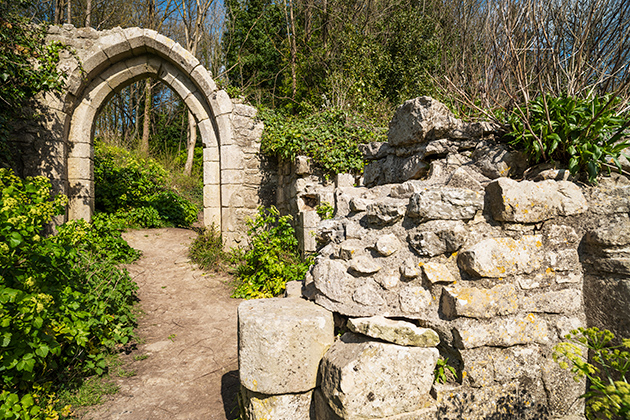Church Ope Cove (‘Ope’ being a local word for an opening down to the water) is a small, secluded cove on the eastern side of the Isle of Portland and is often missed by photographers as they whizz on by to its more famous neighbour, Portland Bill Lighthouse.
Before you reach the cove, make sure that you visit the ruins of St. Andrews Church, Portland’s first parish church. Situated in a small wooded valley, the church has long lain derelict and all that remains now are overgrown walls, an arch and several tombstones. It’s an interesting location particularly with black & white infrared techniques, but possibly even more dramatic with a sea fret swirling around the cliffs. You can also access the cove via Portland Museum, through an arch, which is part of the crumbling remains of the 15th century Rufus Castle, and in its day would have commanded spectacular views over the cove and its approaches.
Church Ope Cove has a small community of beach huts nestled at the back of the cove and then for the most part it is pebble heaven. The cove was once covered in sand but debris from quarrying the valuable Portland stone has been dumped into the cove and over the years the action of the tides has rounded and shaped the stones. This is a great location for shooting long exposures of waves around the pebbles but also a superb spot for creative pebble stacking and crashing waves. One of the advantages here is that it is very sheltered from the prevailing winds so you can get big waves without the wind whistling around your ears.

Saint Andrews Church. Nikon D810, 21mm, 1/80sec at f/11, ISO 64, LEE Filters polariser. Credit: Jeremy Walker
Shooting advice
Portland, on Dorset’s Jurassic Coast, is reached via the A354, which crosses Chesil Beach and goes through the village of Easton. Just after the hamlet of Wakeham and about 100m from Portland Museum there is a small free car park on the right. It is signed Church Ope and Museum. From the car park there are two footpaths down to the cove. One lies almost opposite and leads down through the woods via the church, and the other starts 100m away from the museum and leads you past the crumbling castle ruins. Church Ope Cove may not be an obvious sunrise or sunset location but it is worthy of a few hours’ photographic exploration, perhaps on your way to the lighthouse for sunset. Whatever your photographic interest, try and go as light as possible with your kit as it is a steep climb back to the top.
Food and lodgings
If you fancy a bite to eat while you’re in the area, the Hayloft Café is just 100m from the car park in the grounds of Penn Castle. Alternatively, try the Lobster Pot, which is about a mile along the road at Portland Lighthouse. Obviously the lighthouse itself is a big draw for photographers, so you might want to factor in a little extra time to explore the site. Also, the Heights Hotel does very good food and is a great place to drop into for a coffee, or to shelter from bad weather. The hotel is a great place to stay if you’re spending a few days location hunting and shooting in the area. It’s also about three minutes by car from Church Ope, making it an excellent base for exploring the beach.

Pebble stack. Nikon D810, 24-70mm, 1/1250sec at f/4, ISO 64. Credit: Jeremy Walker
Kit list
- Filters Church Ope Cove doesn’t need any specialist photographic equipment but a sturdy tripod and some filters from the LEE Filters ‘Stopper’ range will be very useful for capturing long exposures of waves swirling around the rocks.
- Assortment of lenses At low tide more rocks are uncovered and this allows for ample macro and close-up imagery to be achieved, so a macro lens may come in useful. This area isn’t a long lens location, so a 16-35mm or 24-70mm (full frame) will be ideal.







